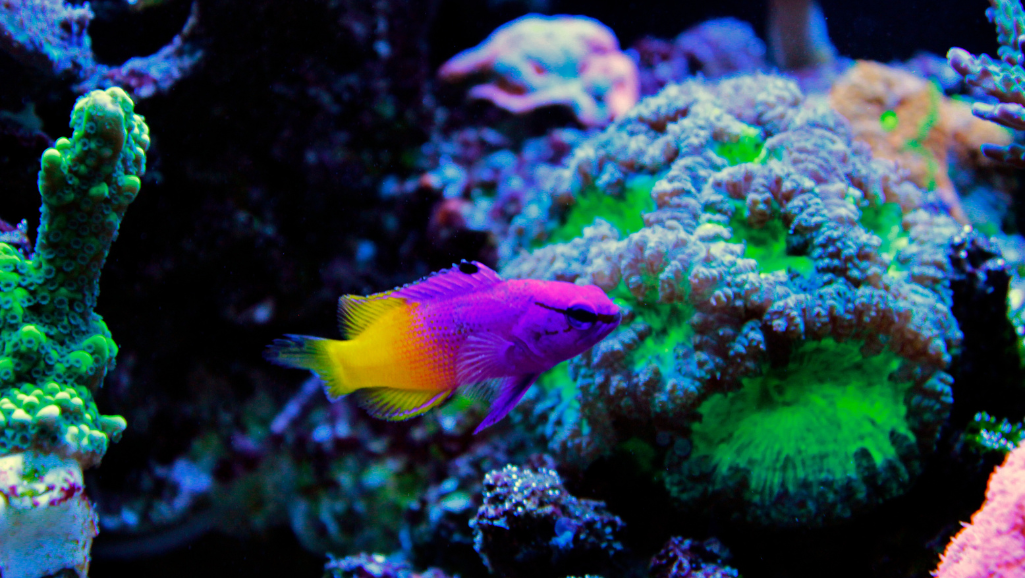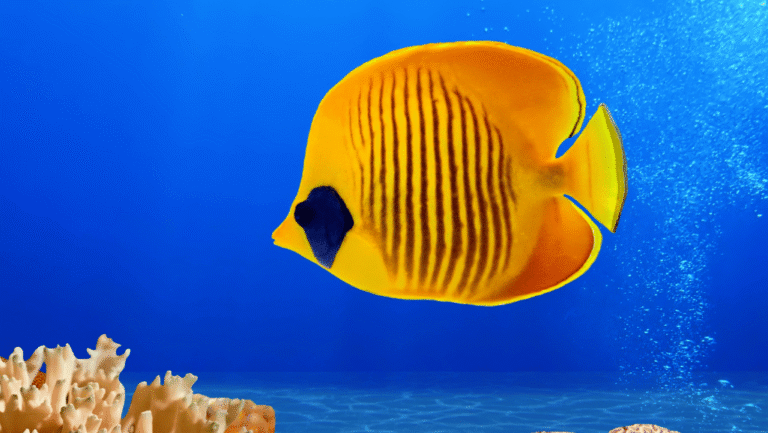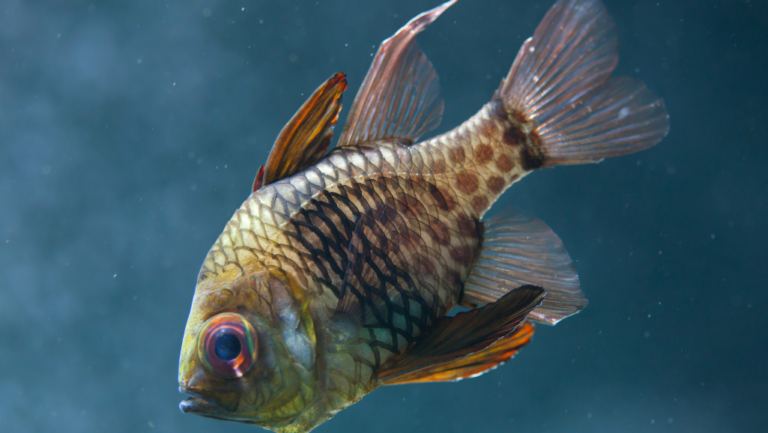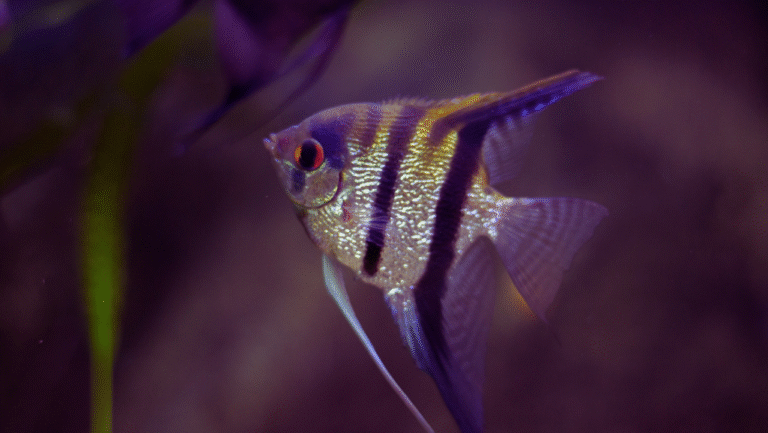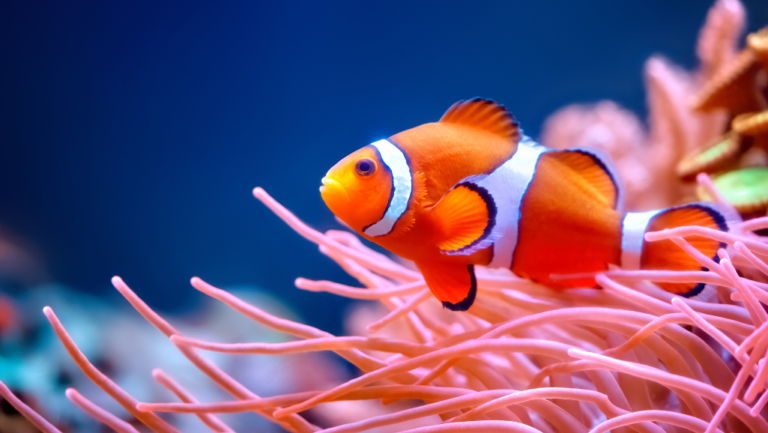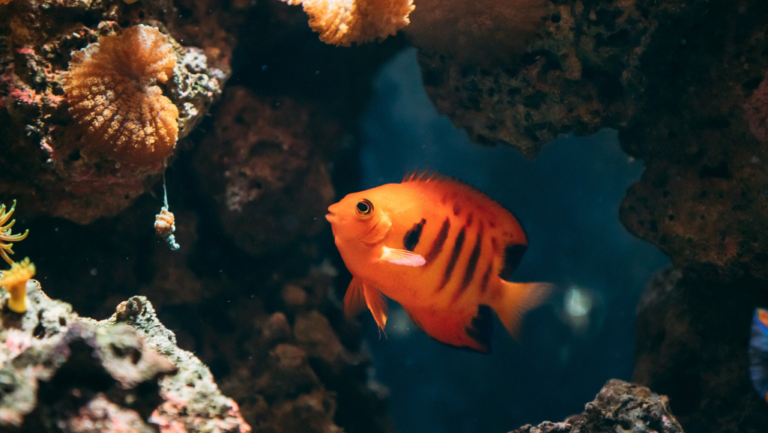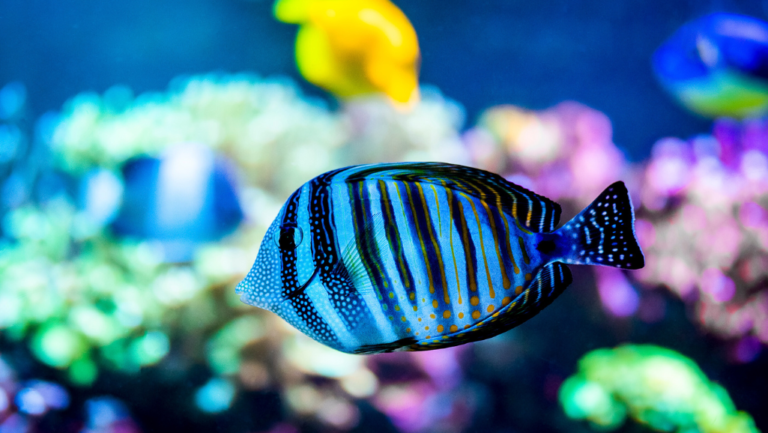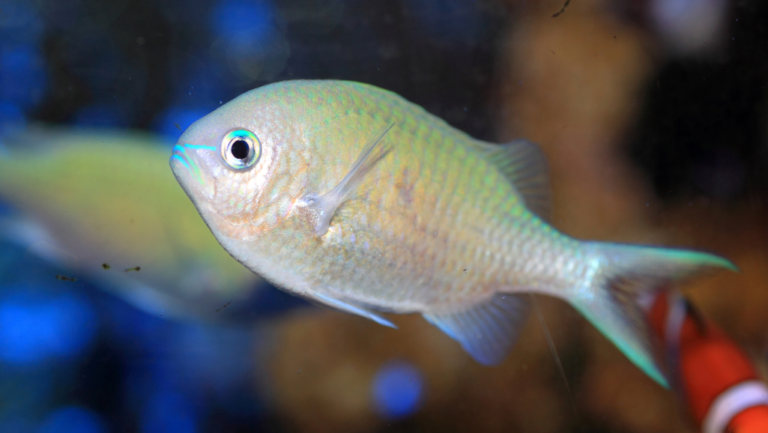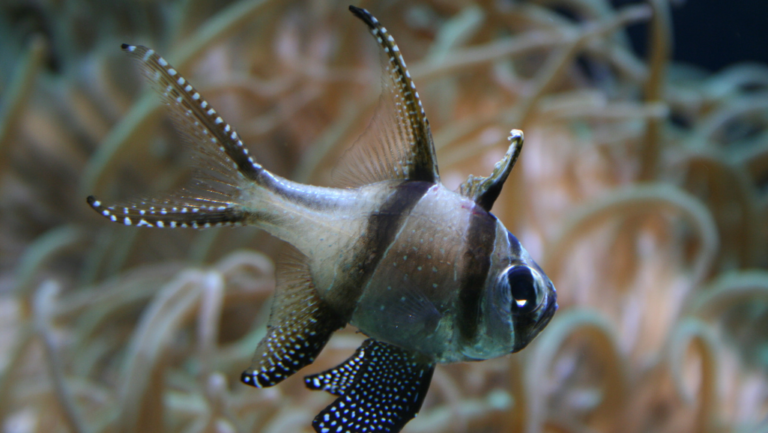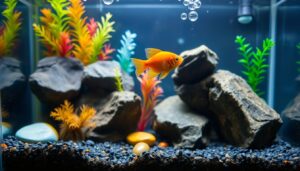The Royal Gramma, also known as Gramma Loreto or Fairy Basslet, is a stunning addition to saltwater aquariums. They have vibrant purple and yellow colors and a black spot on their dorsal fin. These fish are loved for their graceful swimming and small size.
But, Royal Gramma Care is key. They need clean water and stable temperatures to thrive. This guide will help you keep your Royal Gramma happy and healthy in your aquarium.
To create a great home for your Royal Gramma, learn about their tank needs and diet. For a vibrant aquarium, check out our guide on amazing tank fish. Turn your aquarium into a paradise for these beautiful fish.
Key Takeaways
- A Royal Gramma needs a tank of at least 30 gallons to thrive.
- Keep the water temperature around 78°F and pH levels between 8.1 and 8.4 for their health.
- They are peaceful fish and should be kept with non-aggressive tank mates to prevent stress.
- Feed them a diet rich in zooplankton and small crustaceans to mimic their natural feeding habits.
- It’s important to source Royal Grammas from sustainable breeders to promote ecological responsibility.
- Regular tank maintenance and consistent water quality checks are essential for Royal Gramma Care.
- Though breeding in captivity can be challenging, under the right conditions, it is possible.
Overview of Royal Gramma Fish
The Royal Gramma, known as Gramma Loreto, is a stunning addition to saltwater aquariums. It’s also called the Purple Coral Fish or Fairy Basslet. Its bright colors and calm nature make it a favorite among fish lovers.
The Royal Gramma’s beauty starts with its deep purple front half. This color changes to bright yellow towards the tail. A black mark on its dorsal fin adds to its royal look. This small fish grows to about 3 inches and can live up to 5 years with good care.
Description and Characteristics
Gramma Loreto, or Fairy Basslet, has a torpedo-like body. It’s wider at the front and narrower at the back. This shape helps it move easily around coral reefs and rocky areas.
Natural Habitat
The Royal Gramma lives in the warm waters of the Western Atlantic. It’s found from the Bahamas to Bermuda and parts of Central and South America. They like depths up to 300 feet with lots of rock and reef crevices. In aquariums, they need plenty of hiding spots and live rock to be happy.
General Behavior
The Royal Gramma is a calm fish that likes to hide in live rock. It’s known to swim upside-down in coral and caves. This shows its adaptability and survival skills. But, it’s important to keep only one in a small tank to avoid territorial behavior.
They eat zooplankton but also accept other foods. This makes them easy to care for in a well-kept aquarium. They help keep the tank clean by eating parasites from other fish. This makes the tank healthier for all the fish.
The Royal Gramma is loved for its beautiful colors and easy care. It’s a great choice for both new and experienced fish keepers. It adds color and peace to any aquarium.
Setting Up an Ideal Aquarium
Creating the perfect Royal Gramma Tank Setup starts with knowing what this vibrant Saltwater Aquarium Fish needs. Follow these guidelines to make a great home for your aquatic pet.
Aquarium Size and Dimensions
A minimum tank size of 30 gallons is key for your Royal Gramma. They are territorial and can jump, so a secure lid is a must. Also, they love deep tanks that remind them of their natural home in deep water reefs.
Water Conditions and Parameters
Keeping your Royal Gramma healthy means paying attention to water conditions. Keep the temperature around 78 degrees Fahrenheit. The pH should be between 8.1 and 8.4, and the specific gravity should be 1.025 for the right salinity. Good filtration is important to protect their slime coat. A stable water heater is also needed to keep the tropical conditions right.
Adding these details to your Saltwater Aquarium Fish habitat will help your Royal Gramma thrive. Following this setup guide will create a stable and healthy home for these amazing creatures.
Diet and Feeding Tips
Good nutrition is key for the Royal Gramma’s bright colors and long life. Knowing what to feed them is important for Royal Gramma Care. These fish love a varied diet that’s similar to what they eat in the wild.
Best Food Options
Royal Grammas eat tiny zooplankton and small crustaceans in the wild. In tanks, they need high-quality frozen foods like mysis shrimp and brine shrimp. They also like prepared fish foods.
Adding commercial foods like Ocean Nutrition Prime Reef Flakes or New Life Spectrum (NLS) pellets is good. Live foods, like brine shrimp, help them stay healthy and active.
Feeding Schedule
It’s important to feed them like they do in nature. Small meals throughout the day is best. This way, they don’t get too full and all fish get to eat.
Potential Eating Habits
Watching how they eat can tell you a lot about their health. They might be shy at first but will eat well once they feel safe. Their eating habits show how well they’re doing in their tank.
To keep your Royal Gramma healthy, feed them a balanced diet regularly. This helps their colors stay bright and their immune system strong. It makes for a happy and healthy aquarium.
Compatible Tank Mates
Choosing the right tank mates is key for a peaceful Royal Gramma environment. The right friends help the Royal Gramma stay healthy and colorful. Here, we look at who can and can’t live with this beautiful basslet.
Peaceful Aquarium Companions
For a calm and lively tank, pick friends that match the Royal Gramma’s calm nature. Good choices include:
- Angelfish
- Gobies
- Hawkfish
- Boxfish
- Blue Green Chromis
- Clownfish
These fish get along with the Royal Gramma, as long as there are plenty of hiding spots. This prevents fights over territory. For more tips on creating a great tank, check out compatible tank mates for Royal Gramma.
Species to Avoid
Some fish are not good tank mates for the Royal Gramma. Aggressive species can stress or harm your fish:
- dwarf lionfish
- eels
- groupers
- snappers
- Royal Dottyback and similar looking/behavioral fish
These fish might bully or attack the Royal Gramma. This can cause stress and hiding. Choose tank mates wisely to keep your Royal Gramma happy. A well-thought-out Royal Gramma Tank Setup is essential for peace among tank mates.
Health and Disease Prevention
Keeping your Royal Gramma healthy means knowing about common diseases and how to prevent them. These colorful fish show their health through their vibrant colors. So, it’s important for aquarium lovers to keep them well.
Common Illnesses in Royal Gramma
Royal Gramma care starts with knowing about diseases like Ich, Marine Velvet, and Lymphocystis. Ich looks like white salt spots on the fish’s body, showing a parasitic infection. Marine Velvet is a dusty white film that can be deadly if not treated fast.
It’s vital to watch for these diseases early and act quickly. This can save your fish’s life.
Signs of a Healthy Fish
A healthy Royal Gramma swims well, eats eagerly, and has bright colors. These signs mean your fish is happy and healthy in its new home. Keeping the tank’s water stable is key to keeping these signs.
Make sure to follow recommended water parameters to keep your fish thriving.
Treatment Options
To treat diseases like Ich and Velvet, isolate the sick Royal Gramma in a quarantine tank. This stops the disease from spreading. The 80/20 Quarantine method helps manage stress and break the parasite’s life cycle.
For the right treatment, talk to a marine vet. They’ll help you choose the right medicine and keep your main tank stable.
Keeping your Royal Gramma healthy also means regular tank care and water checks. A stable diet is also important. These steps help prevent disease and keep your aquarium lively.
Aquarium Maintenance for Royal Gramma
Keeping your Royal Gramma’s home clean and stable is key. Royal Gramma tank setup and regular care are vital. They help keep the delicate balance in saltwater ecosystems, letting these colorful fish thrive.
Tank Cleaning Routine
Cleaning the tank well is essential to stop disease and keep your Royal Gramma’s home healthy. The steps include:
- Algae removal: Scrubbing the tank walls often to stop algae from taking over and stealing oxygen.
- Substrate cleaning: Vacuuming the substrate with a siphon to get rid of food and waste. This stops harmful ammonia and nitrate levels.
- Check and organize decorations: Make sure rocks and decorations don’t trap bacteria in dead spots.
Water Changes and Filtration
Keeping the water quality high is critical for Royal Grammas. This means:
- Regular water changes: Changing 10-20% of the tank water each week to keep it clean and balanced.
- Efficient filtration: Using a strong filter to remove waste. Make sure the intake valves don’t suck in the fish.
- Adding powerheads to create natural water flow. This helps with oxygen and water circulation.
For more tips on saltwater aquarium fish, check out this link. It has great info for creating the best home for your Royal Gramma.
Regular tank upkeep is not just for health. It also makes your Royal Gramma’s colors pop and their behavior better. They’re perfect for both new and seasoned marine lovers.
Breeding Royal Gramma Fish
Breeding Royal Gramma or Purple Coral Fish is an exciting journey. It needs careful planning and a perfect environment. A calm tank with lots of hiding spots is key for breeding.
These fish are delicate and need a quiet place to spawn. A peaceful tank is essential for their breeding success.
Breeding Conditions
Royal Grammas lay 5 to 40 eggs each night. The male builds a nest from algae to attract the female. A 30-gallon tank with a temperature of 72-78°F is best.
The water should have a specific gravity of 1.020-1.025 and a pH of 8.1 to 8.4. This mimics their natural habitat. Watching the male build his nest and the pair’s dances can show if spawning is successful.
For more on setting up a marine aquarium, check out a guide on saltwater aquariums.
Caring for Fry
After 5–7 days, the eggs hatch. The fry need a separate tank and food like copepods or rotifers. As they grow, they can eat larger food like Artemia nauplii.
It’s important to feed them regularly and with the right food sizes. This helps them grow well. They usually look like Royal Grammas after 3 to 4 weeks. Setting up the tank right is key for their early life.
